How to plant a tree – and what to do when a tree is planted wrong
The way you plant a tree makes a huge difference to whether it will survive.
A badly planted tree won’t necessarily fail in the first year, according to award winning garden designer Jamie Butterworth, MD of Form Plants tree and shrub nursery. But it will fail at some point.
And a tree can be quite an investment in the garden. We’re all being urged to plant trees as part of improving air quality and re-foresting our environment. But if the trees aren’t planted properly, that time, effort and money will be wasted.
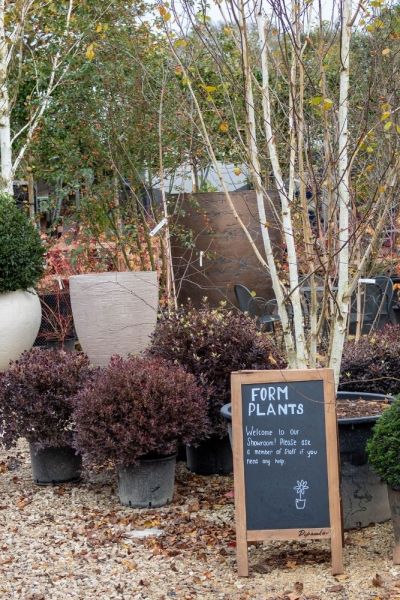
Form Plants sells specimen and specially shaped trees and architectural plants to garden designers, and also to the general public.
So I asked Jamie how to plant a tree properly. His advice also made me look again at some of the trees, I’ve planted in my own garden. Then I realised that some were planted quite badly. There are three common problems, so I’ll explain how we sorted each one out.
How to plant a tree properly
Jamie says that the most important thing is to plant your tree at the right depth. The point at which the roots join the trunk needs to be level with the ground. If the roots are planted too deeply, the tree will fail.
Some people will advise you to dig a round hole. Others say it must be square. Jamie says that he has investigated research on both methods carefully and it doesn’t seem to make much difference.
There is some debate as to how wide the hole should be. If you practice no dig/no till gardening, you only dig the hole as wide as the current tree roots. Leave the soil around the hole undisturbed.
If you garden traditionally, you will be told to dig a hole two or three times as wide as the tree roots. And loosen the soil around the hole.
Either way, fill the hole with water and let it drain.
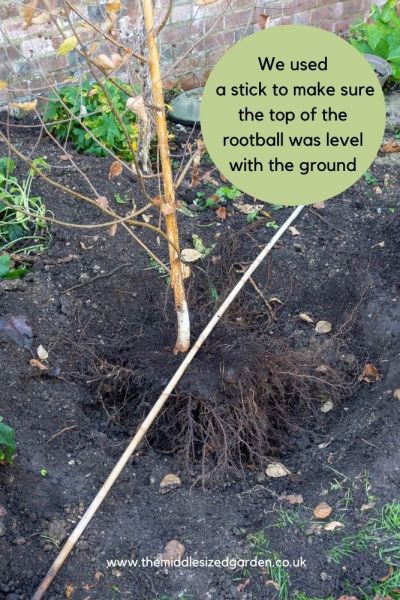
We placed the tree in the hole and laid a stick across it to check the level was right.
Be sparing with compost but add mulch on top of the soil
Once the tree is placed in the hole, Jamie suggests that you use the soil you have dug out of that hole to backfill it. ‘You could add some compost, but don’t add too much,’ he says. But add another layer of mulch on top of the soil around the tree, as that will feed the soil near the tree and encourage the roots to spread.
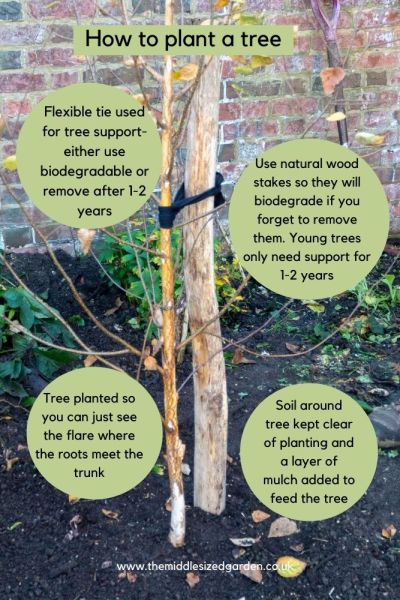
How to plant a tree correctly. Use a soft, flexible tie and a natural wood stake. Remove both after a year or so.
Using tree stakes and ties
A young tree needs staking for the first year or two. Jamie says you should use a natural wood stake, not one that has been treated. ‘People often forget to take the support away, or they move house,’ he says. ‘But a tree shouldn’t be supported for too long. A natural wood stake will biodegrade over time. He suggests using biodegradable ties for the same reason.
Tree ties should flexible, too, so that they don’t cut into the tree when it blows in the wind or grows. I’ve used BioStretch soft garden twine and BioStretch Tree Ties. Both biodegrade and fall off in around 2 years.
Note that links to Amazon are affiliate and help support this blog. See disclosure.
How deep should you plant a tree?
A tree should be planted as deeply as its root ball, says Jamie. The place where the trunk flares to meet the root ball should be level with the ground. If the tree is buried too deeply, the trunk will stick straight out of the ground like a pencil. You won’t be able to see the flare as the trunk joins the roots. The trunk is likely to rot, and, at some point, the tree is likely to fail.
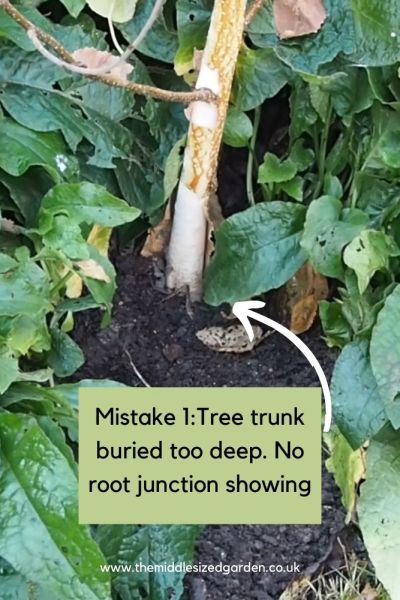
Jamie Butterworth says that the number one mistake when planting trees is planting them too deep. The root junction with the trunk needs to be level with the ground so that you can just see the flare as it widens out. If your tree goes into the ground as if it were a pencil, the roots are too deep.
‘Don’t rely on the tree being planted at the right depth in the pot,’ he says. ‘You may have to clear away some mulch or compost to identify the root junction.’
When is the best time of year to plant a tree?
The best times of year to plant a tree are autumn and spring. Don’t plant in winter, if the ground is frozen. But if you have mild winters, you can also plant then. If you plant your tree in summer, the weather may be too hot and dry, so the tree will struggle to get established. However, regular watering will help the tree survive.
How to care for newly planted trees
Newly planted trees need some care or they may die. The most important thing is to make sure they’re watered regularly in dry weather. If you’re planting community trees, make sure there’s a rota or that someone is responsible.
You don’t need to fertilise trees, but add a layer of mulch or compost on top of the soil around the tree. Make sure you don’t cover up the trunk, though. Jamie uses peat free Dalefoot Wool compost.
Don’t allow weeds, grass or other plants to grow too close to the base of the tree.
Remove stakes and tree ties after 1-2 years.
What to do if your tree has been planted wrong
So after our visit to Form Plants I checked out some of the trees at home. Several had been planted badly, mainly by me.
Let’s start with planting a tree too deep. I recently wrote about what to do with a difficult shady corner where a pergola had collapsed. I decided to add another silver birch tree to the garden, plus some easy shade loving planting. Silver birches don’t like a very shady spot, but as soon as the tree grows higher than the wall behind it, it will get plenty of sun.
So I planted a silver birch, but forgot to think about the depth of planting. As a result, a small amount of the trunk is indeed under the earth. I’ve planted it a couple of inches too deep.
I also planted some comfrey nearby. But comfrey can be quite invasive and it spread to the base of the trunk. Trees, especially newly planted ones, need lots of nutrition from the soil. They don’t do well if grass, weeds or plants are planted too close.
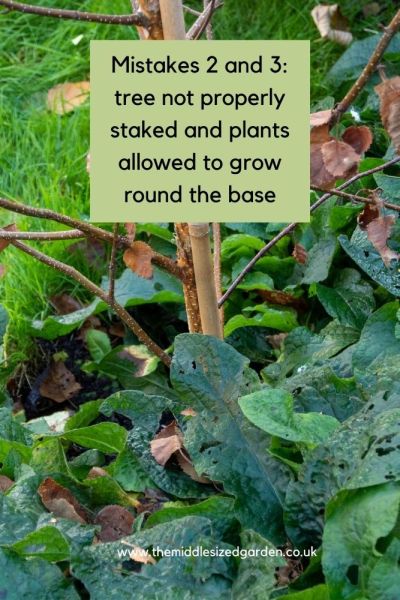
And I’ve just used a slender bamboo cane to support this tree. It’s not adequate. Plus I’ve allowed comfrey to grow right up to the base of the trunk. I really was not concentrating when I planted this!
What to do if your tree has been planted too deep
If it’s a fairly young or recently planted tree, it should be safe to dig it up and re-plant it at the right depth. As I only planted this silver birch six months ago, there’s unlikely to be any problem re-planting it.
I’ve noticed that the longer a tree or shrub has been in the ground, the less likely it is to survive being moved. But young trees and plants can be moved quite easily, as long as they’re re-planted properly.
Sometimes you can scrape away the soil…
I have a liquidambar tree that appears to have been planted too deep. It was planted by someone who used to help me in the garden around five years ago. It’s on a slight slope. So he tried to make sure that water would go down into the roots rather than sliding down the slope by piling up the soil in a circle around the trunk. He left the base of the trunk free of soil so that there was a little well or moat just around the base of the tree.
But, over the years, the soil has washed into the well area and buried the junction where the trunk meets the roots.
So we scraped back the soil to reveal the junction with the roots. As he’d piled soil up, it was relatively easy to take it back to the right level.
Looking back at earlier posts, I discovered that I had planted two holm oaks too deeply in 2014. They had both been pushed over by a storm. However, once again, the soil had been built up around them, so we didn’t dig them up. We scraped the soil away. It was a real joy to compare what the holm oaks looked like then to what they look like now.
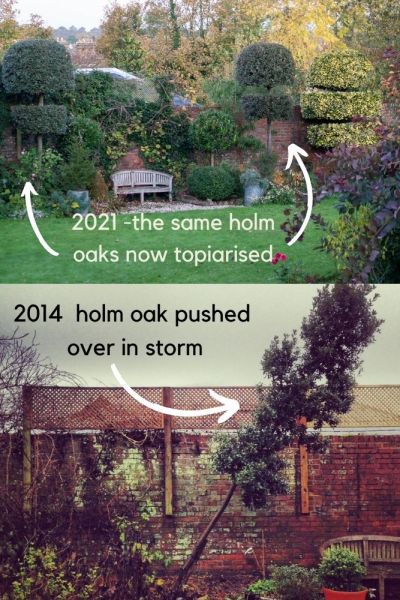
When these two holm oaks were pushed over in a storm about three years after they were planted, I thought they wouldn’t survive. But the top image shows how they look now.
Other tree planting problems – what to do
You should remove tree stakes and ties within two years. One of my trees has been staked for around five years, so we’ve removed it.
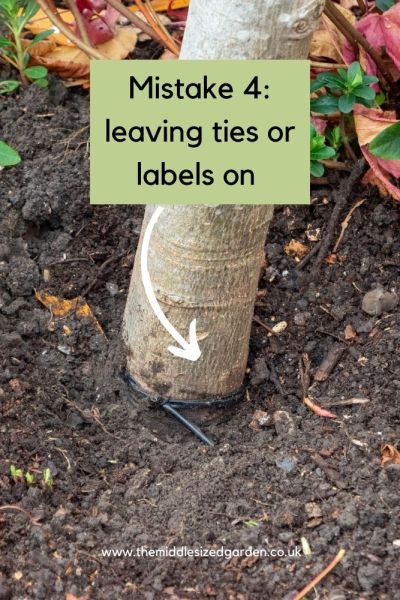
You can just see that a tight tie has been left on this tree, just below the soil so we hadn’t noticed it. If a tight tie is left on a tree, it cuts into it and damages the tree as it grows. It could even ultimately kill the tree.
While I was checking the liquidambar planted around five years ago, I also discovered that a tie had been accidentally left on. I think it was part of the labelling. It was digging into the trunk as the tree grows. This can ultimately cause tree death.
These problems are easy to sort. It’s just a question of taking off any tight labels and removing the stakes.
Tree planting problems with an older tree
The third problem tree was another silver birch at the back of the garden.
Around eleven years ago, we redesigned the garden. I was still an inexperienced gardener. There was, I think, something of a fashion for planting three trees in the same hole or very close. The idea was that it would mimic a multi-stemmed effect. And it would restrict the growth of larger trees in small gardens, because they would compete for nutrition.
However, personally, I’ve never known this method of planting three trees very close together work. I only know a few people who have actually done it, so that’s not a scientific observation. But it’s also been some time since I even heard this technique recommended.
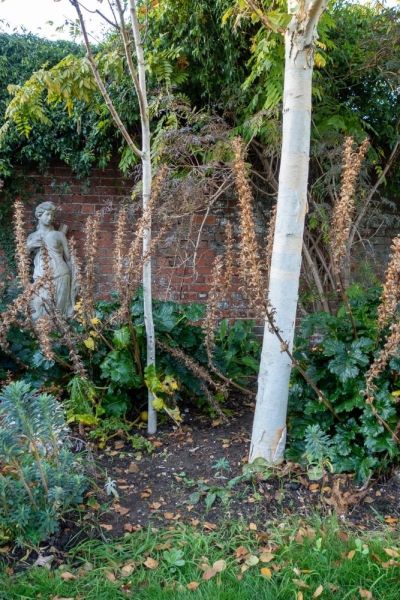
These two trees were planted eleven years ago, along with a third tree which quickly died. As you can see, one tree has flourished while the other has barely grown. The idea is that this method restricts the growth of larger trees in smaller gardens. Sadly, it doesn’t seem to restrict the growth of them all equally.
One tree had more sunlight and was planted better. It has thrived. One tree was planted too deep and had less sunlight. It looks pretty miserable. The third tree died soon after planting, so we took it out. But the difference between the healthy tree and the tree that has barely grown is now quite obvious.
However, this tree may not like being moved, as it’s been in situ for so long.
But there’s no point in leaving it where it is. So we dug it up and has moved it to somewhere it can get its own share of light and nutrients. It’s also now planted at the correct depth. We shall see if it survives.
More tips on choosing and growing trees
If you want a multi-stemmed effect, buy a multi-stemmed tree. If you want a larger tree for a smaller garden, there are better ways of restricting growth than planting them in one hole. See my other interview with Jamie Butterworth for some brilliant ideas for trees for small gardens.
And here’s advice on choosing trees for privacy, how to choose a tree that’s perfect for your garden, choosing trees for autumn colour and how to deal with a sudden sign that your tree is dying. Just in case you think your garden is too small for a tree or trees, read about this small town garden which has an orchard of several hundred trees.
If you’re planning work on your trees, it’s essential to use someone who is qualified. Tree work can be very dangerous. There are more accidents with amateurs, trees, ladders and chainsaws than in any other area of gardening. Find out the difference between an arborist, tree surgeon and chain saw man here.
It’s also important to have your trees pruned well. Nobody loves a badly hacked-about tree. This post on how to prune trees for light and privacy is worth reading because it emphasises the importance of tree shape.
Alan Titchmarsh has also written a useful book on Trees for Small Gardens.
Pin to remember how to plant a tree
And see here for a free weekly email with more tips, ideas and inspiration for your garden.
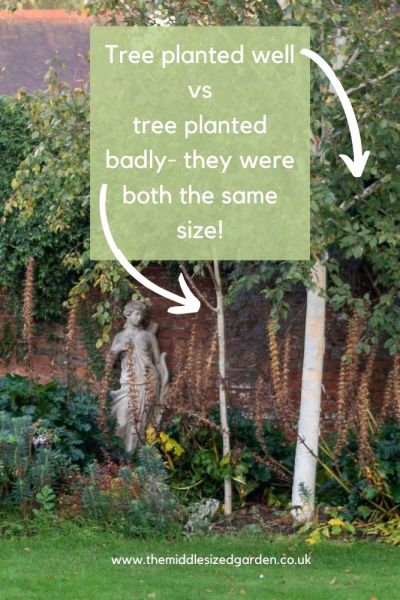
























Very interesting and timely article. Can you clarify if I plant the tree in soil to the root / trunk junction can I then place the mulch higher than this ? If so how deep should the mulch be?
Don’t let the compost or mulch cover the root/trunk junction. Use a 2-3″ layer in the general area around the tree, but make sure it doesn’t touch the trunk itself. Maybe stop at least 6″ away from the trunk. The mulch will enrich the soil around the tree planting hole over the following months. That will help encourage the roots to spread out and get established.